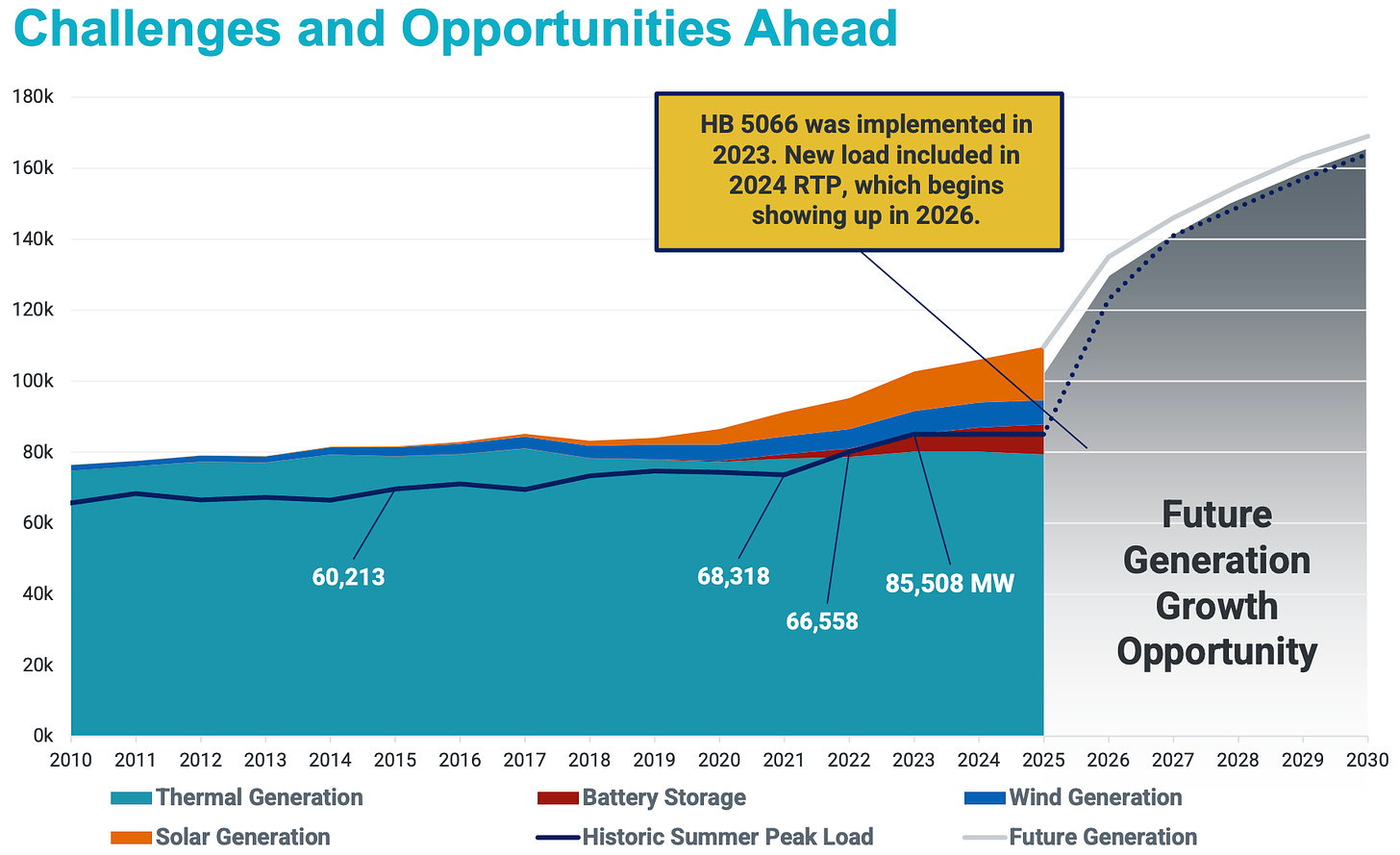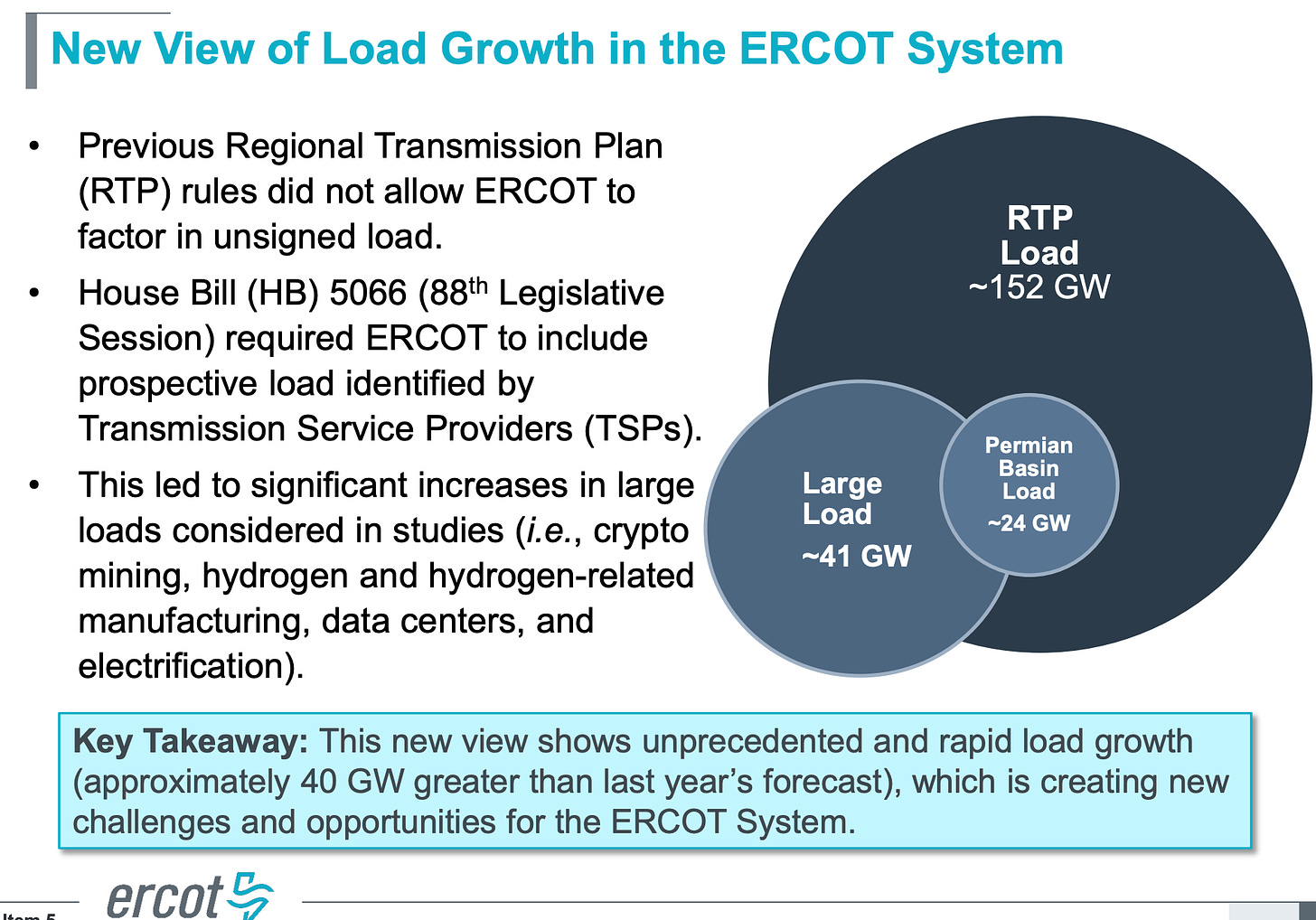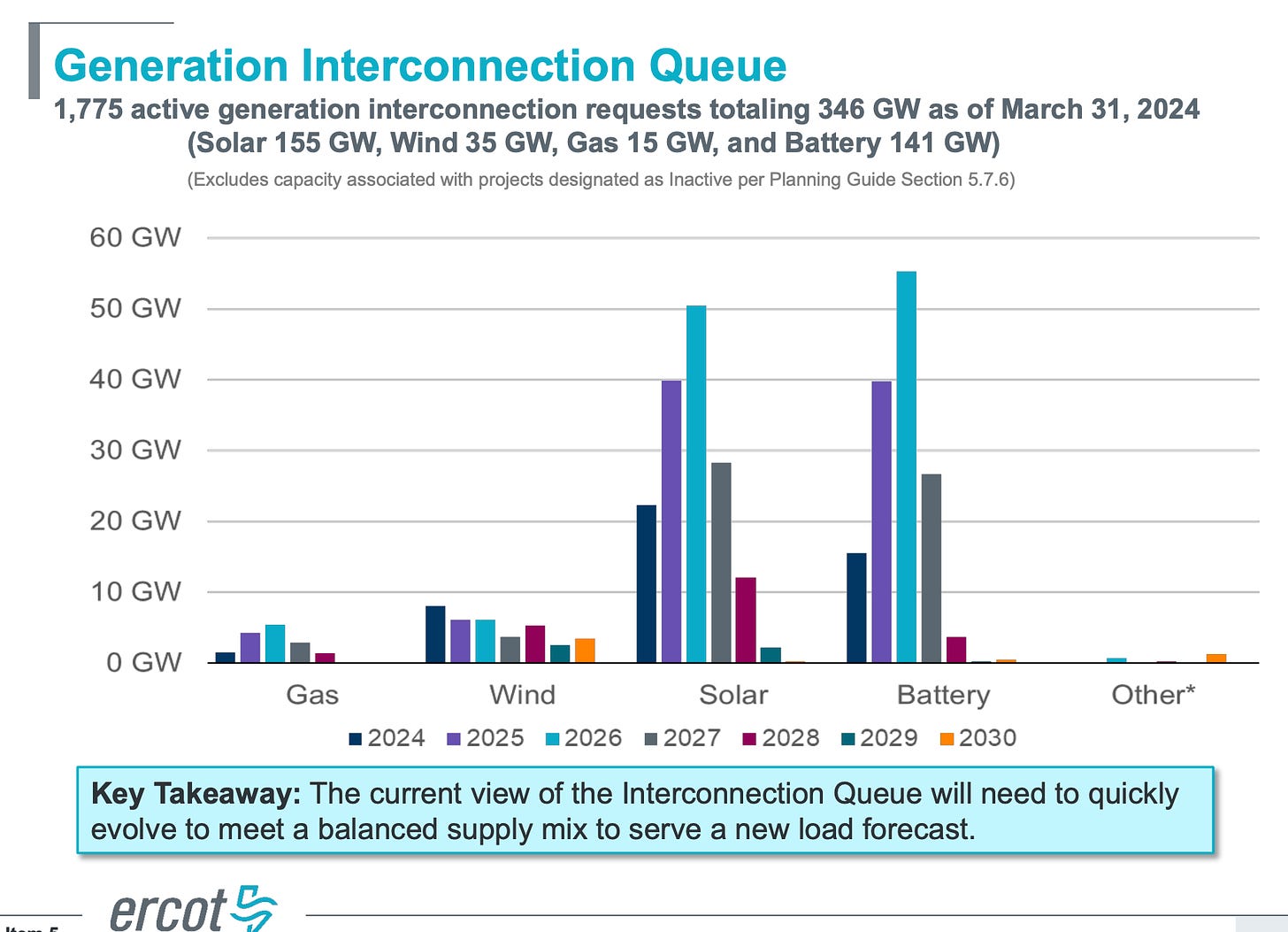ERCOT Projects Texas Electricity Demand to Double by 2030: Opportunity or Impending Disaster?
EPA's recent rules will shut down all existing coal-fired and base load natural gas generation, virtually guaranteeing that expected demand growth cannot be met.
Slide from “CEO Update” presentation to ERCOT Board of Directors by CEO Pablo Vegas, April 23, 2024
According to some pundits, something terrible is happening in the United States: the electricity demand is surging after being roughly flat for the last two decades. An increase in electricity demand would indicate economic growth, which would usually be considered a good thing, so why is increasing demand for electricity terrible? According to the New York Times, “A Surge in Electricity Demand is Threatening U.S. Climate Goals.” Even worse, the NYT emphasizes in their subtitle, “A boom in data centers and factories is straining electric grids and propping up fossil fuels:” Oh, the horror! Anything that props up fossil fuels must be bad, according to the NYT.
The NYT also noted that one of the best examples of surging electricity demand is Texas. Texas electricity growth for the last 20 years has roughly tracked population growth, with power consumption increasing at a compound annual rate of 1.7% between 2003 and 2022, while the population increased by 1.6%. ERCOT is now projecting electricity demand in Texas to double in just six years. This growth will be propelled by population growth and large-load industrial growth, such as cryptocurrency mining and the electrification of the Permian Basin oil and gas industry.
In a presentation to ERCOT’s Board of Directors on April 23, 2024, ERCOT’s President and Chief Operating Officer, Pablo Vegas, started with the shocking graph (above) showing the “future generation growth opportunity:”
The “key takeaways” from this presentation, according to Mr. Vegas said, are:
The ERCOT region is forecasted to experience tremendous electric demand growth in the next 5-7 years, which is driving the need for ERCOT to adapt and plan differently for the future.
As a result, ERCOT is adapting and entering a new era of planning to address long-term challenges and highlight future opportunities.
With this new era of planning and the tools from the last two Texas Legislative Sessions, ERCOT is in a better position today than it ever has been to meet today’s and tomorrow’s challenges.
In other words, ERCOT is facing unprecedented challenges to increase electricity generation by many multiples of average growth rates for decades. With coal plants in Texas and all over the U.S. closing and natural gas-fired generation facing the end of its economic life, the EPA added a new hurdle for Texas and other U.S. power grids.
Two days after Mr. Vegas presented this information to the ERCOT Board and released it to the public, the Environmental Protection Agency (EPA) released its final rules, which are designed to shut down all current and future coal-fired power generation and baseload natural gas electricity generation. Unless the Supreme Court invalidates the EPA rules, these regulations will guarantee that ERCOT will not meet the projected demand growth and will experience shortages and even blackouts.
Texas expects explosive growth in electricity demand
The recent upward revision in electricity growth in Texas is 40 gigawatts (GW) greater than their forecast last year, which the ERCOT CEO optimistically described as “creating new challenges and opportunities for the ERCOT system.” Such explosive growth would be a challenge even in normal market conditions, given the long lead times required to design, permit, build power plants, and construct the transmission lines and infrastructure needed to transport the power to end users.
ERCOT’s new view of load growth on its system is comprised of three components:
(1) regional transmission plan (RTP) growth of 152 GW, comprised of residential and related commercial and light industrial loads;
(2) large load growth of 41 GW, comprised of heavy industry including artificial intelligence (AI), crypto mining, hydrogen, and hydrogen-related manufacturing, data centers, and “electrification,” including increased home heating loads due to government programs that encourage the substitution of heat pumps for natural gas heat, EV charging stations, and other government programs designed to “electrify everything;” and
(3) Permian Basin Load growth of 24 GW, which is coming as the oil and gas industry operating in the Permian Basin electrifies their drilling and producing equipment.
Vegas summarized ERCOT’s expected load growth in the following slide:
This huge load growth comes as ERCOT recently issued an unprecedented Spring warning in April of 2024 before the summer air conditioning load in Texas.
With ERCOT’s generation load expected to double in just six years and the EPA’s rules killing coal-fired generation and severely limiting natural gas generation, ERCOT is facing a dangerous situation. ERCOT’s current pending interconnections queue is over-weighted with solar projects, which will introduce significantly more instability to the ERCOT grid. Even if all pending battery projects are built, they are inadequate to offset the loss of solar at night and electricity costs in ERCOT will skyrocket due to the high cost of battery storage:
My Take: ERCOT’s pending generation que consists of 10 times more solar than natural gas-fired. Even if all of the battery storage in the que is built, ERCOT will become a dangerously undependable electric grid characterized by rolling blackouts when the sun goes down and the wind stops blowing as is common on summer evenings. The pending 141 GW of battery storage is inadequate to get through a night because battery installations discharge for 4 hours and then must recharge for the next 4 hours. Plus, battery storage is costly, and will drive up the cost of electricity in Texas.
Even worse, EPA new rules will shut down much of ERCOT’s dispatchable natural gas-fired generation. According to Jim Matheson, CEO of the National Rural Electric Cooperative Association:
The path outlined by the EPA today is unlawful, unrealistic and unachievable because the rule oversteps EPA’s authority, relies on technologies that are not ready to deploy and does not give existing coal and new gas power plants enough time to comply.
EPA says it is not responsible for grid stability (see Energy Bad Boys). In other words, if America’s power grids collapse due to insufficient energy policy mandates, it’s not their problem. EPA believes they can destabilize U.S. power grids by issuing bad policies, but someone else must step in and fix them.
This explains why Texas joined 27 other states and industry trade groups to sue the EPA, seeking to block the sweeping EPA rules to reduce carbon emissions from existing coal-fired and baseload natural gas power plants.
Hopefully, these lawsuits will stop the latest EPA rules from destroying U.S. power grids, especially the Texas power grid.
Thank you for reading “Thoughts about Energy and Economics.” This publication is reader-supported, so please “Like” it, share it with friends and colleagues, and become a paid subscriber. Your support is greatly appreciated!







The EPA is either run by or influenced by people and organizations that hate America. The NGO’s such as Sierra Club, EDF, NRDC and many more have more $$$ than the private sector business. The environmental activist/Extremists NGO’s “business” is simply to weaken the U.S.A. by whatever means they can. In some cases they are funded by laundered foreign funds. The United Nations deserves special mention. It becomes apparent with very little research effort, the EPA policies and Rules are no longer about protecting public health or protecting the planet. I have posted dozens of links as references on my blog.
Thanks for another excellent post.
Thanks for your post Ed.
We seem to be on "the highway to hell" as Faith Birol says - only this version of it will destroy
the US before anyone else has a chance to take a shot! (Thanks EPA, FERC... and many other non elected agencies)
The ERCOT interconnection list has been a talking point of mine for about 4 years now and it gets worse every year as seen here. What are we to do if the Energy Fund is not bringing in new gas... with incentives? Are we doomed to cheap and nasty Chinese solar, with a little wind on the side and a large dose of extremely expensive batteries to finish of the cocktail for disaster?
The transmission alone for all that could bankrupt a small nation and Texas is certainly bigger than most nations. They are really pushing for it and for interconnection to other grids.
When a bartender (AOC) and high school dropout (Greta) can shape our nation we are sure in trouble, so Texans need to do what they do best - demand better than this, from our politicians, but you have to stand up and do just that -start making demands! Time to fix this - not just another patch, then another because you can't decide what to do with renewables - if they aren't working for this state time to get rid of them. (I hate to say this but I will... for the greater good!)
We need reliable energy. We need real jobs, real education for skilled labor in this changing market. Texas needs to be the state they want to come to for skilled labor, reliable energy and not government brides to come and use taxpayers money just to be here and fleece the locals.
sorry for the long rant.... but not sorry....